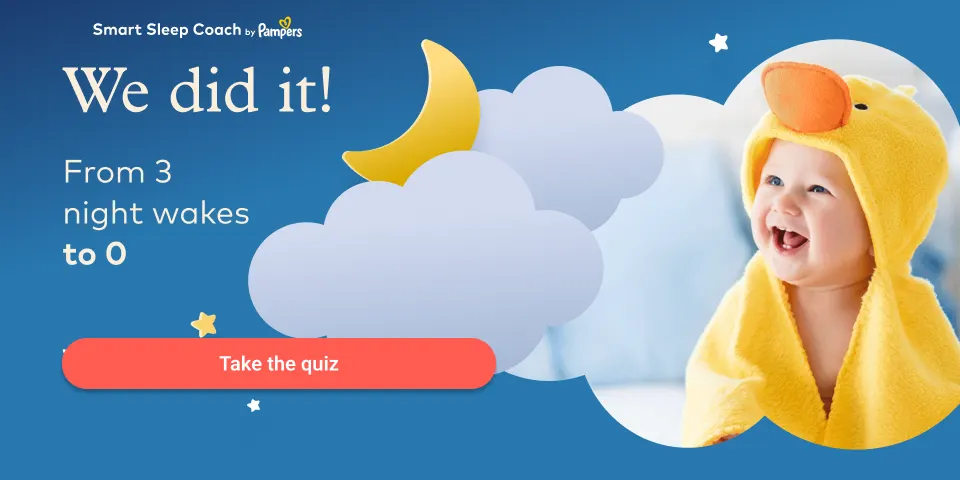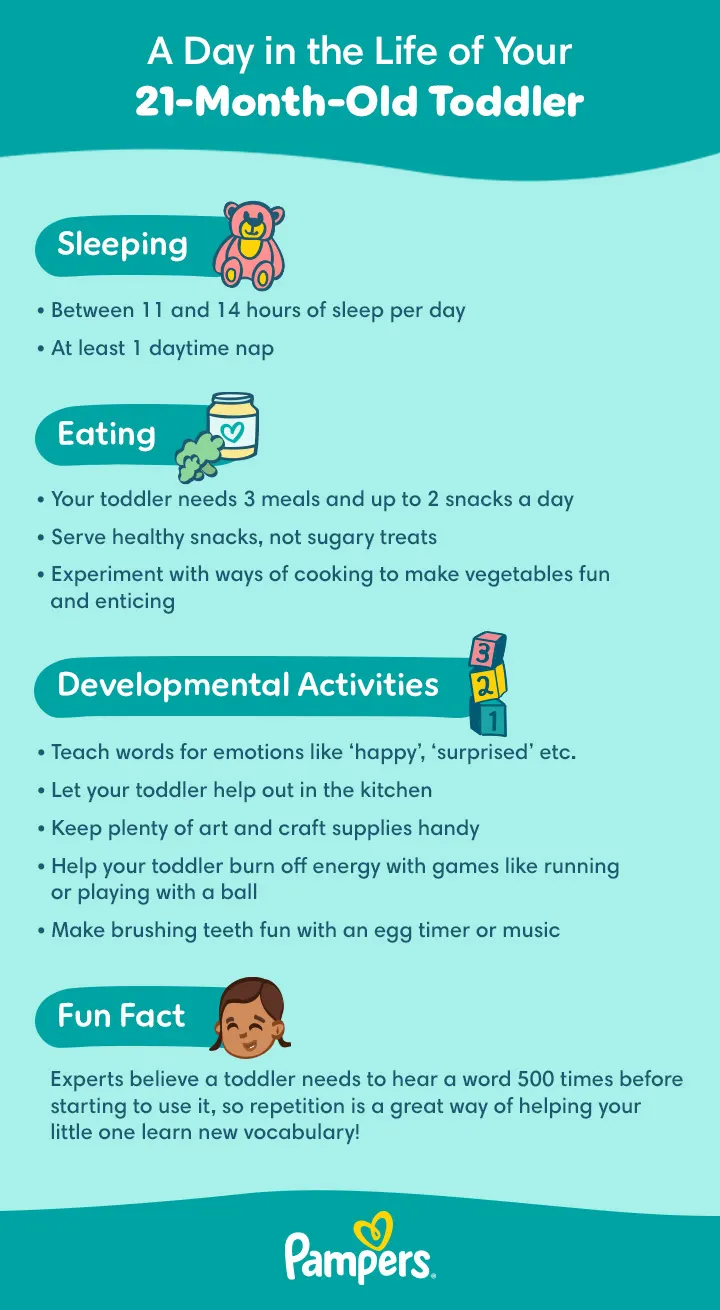21-Month-Old: Your Little Adventurer
Your toddler’s world seems to be expanding almost by the day as he or she gets better at walking, climbing and communicating. Read on to find out what speech and other milestones are in store this month and get some tips for great activities to support your 21-month-old’s development.
21-Month-Old Milestones
Your toddler is a character at this age, and you can expect every day to be an adventure as your 21-month-old learns to do new things, improves existing skills and reveals yet more of that adorable personality.
Though rates of development vary between children, here are some of the milestones that could be reached (or just around the corner) at 21 months old or thereabouts:
Fine Motor Skills: Pouring
You might feel you’ve already had your share of clearing up accidental spills, but don’t put that mop and bucket away just yet! Now your child is developing the dexterity needed to deliberately pour liquid or sand (or that delicious broccoli purée you just made) out of a container.
Your toddler can have endless fun mastering this ability – for example in the bath, tipping water out of cups onto a water wheel or similar bath toy. Channel this new skill and get your little one involved in cooking by measuring out liquid ingredients into cups and so your budding chef can pour them into the mixing bowl for you.
Movement: Poise and Balance
Your 21-month-old’s sense of balance is improving all the time. Around this time, you may notice your child standing on tiptoes to reach for objects on high shelves. If this brings any potential hazards – such as cords and heavy or sharp objects – within range of those curious fingers it might be time to double-check your home’s baby proofing again.
Other signs of your toddler’s developing sense of balance could include:
Carrying large or multiple toys while walking
Pulling toys while walking
Starting to run
Climbing onto furniture and getting down unassisted.
Visual perception: Hide and Seek
Around this age, your toddler may be able to remember where things are hidden, so hiding games can be great fun for a child of around 21 months old. Play ‘hunt the teddy bear’, taking it in turns to hide the bear and look for it. Or hide yourself/each other in a game of hide and seek. Your child may not fully understand the rules but will love the thrill of being ‘found’ or finding you behind the sofa.
Understanding Speech at 21 Months Old: Instructions and Questions
As your toddler’s speech continues to develop, it may start becoming second nature to start giving your child simple instructions like ‘get your shoes’. Ask basic questions like ‘where’s the ball’, and soon you could be delighted to see your 21-month-old pointing to the object (or picture in a book) in question.
And your toddler may be getting better at speaking too. The first simple sentences your little one speaks could just be a couple of words strung together, like ‘bring teddy’, but they’ll melt your heart all the same.
How to Support Your Toddler’s Development
Support your 21-month-old’s development with activities like:
Teaching words for emotions. Make faces in a mirror to show your toddler emotions like ‘happy’, ‘surprised’, ‘sad’. Be warned: Pulling silly faces with your toddler can trigger uncontrollable and highly infectious laughter!
Making brushing teeth fun. Getting those teeth cleaned twice a day is important, so it’s essential to make it a part of your toddler’s daily routine. Make brushing more fun with an (unbreakable) hourglass-type egg timer. Encouraging your child to turn it over and watching the sand run out together while you brush your toddler’s teeth is a fun way of helping your child get used to spending two minutes, twice a day, on brushing. If you don’t have an egg timer, playing music while brushing could work just as well.
Helping your little one burn off energy. Toddlers often have so much energy they don’t know what to do with it. At 21 months old, your toddler needs at least 180 minutes (3 hours) of physical activity a day. This can be spread out over the day and doesn’t mean your toddler has to be tearing around for every minute of that time. Some of the activity can be just moving about and playing. However, it’s important to have some more active time every day, spent doing more energetic activities like running, climbing and playing on the swings and other rides at your local playground. On rainy days, try some of these indoor games for toddlers – like indoor hopscotch – to keep your 21-month-old busy and active.
Getting your toddler to help in the kitchen. Your little helper probably loves joining in with everyday tasks, so if you enjoy cooking it’s a safe bet your toddler will too. Many of the actions you perform when cooking – like pouring things or holding a bowl with one hand and stirring with another – are also great for developing your child’s fine motor skills at 21 months old. Pick an easy recipe to try, go shopping together, and delegate simple tasks, like washing fruits and vegetables, measuring out ingredients like flour or sugar, or stirring. Supervise your child closely at all times in the kitchen.
Unlocking your toddler’s inner artist. Have plenty of paper, crayons, coloured pens, paints and chalk close at hand. Your 21-month-old probably enjoys scribbling and making patterns, so it’s great to have an outlet for all that creative energy. Messier art forms like finger painting are also sure to be a hit with your budding artist.
Mealtimes for Your 21-Month-Old Toddler
A healthy, well-balanced diet is important to support your 21-month-old’s growth and physical development. Offer three meals and two healthy snacks a day.
Your toddler’s diet should include a healthy mix of the four main food groups:
Fruit and vegetables (try and aim for five portions a day)
Starchy foods like potato, pasta, rice and bread
Protein, which can be found in meat, fish and eggs as well as beans and other pulses
Milk and dairy (at least 350 ml of milk a day or 2 servings of dairy foods like cheese and yoghurt) or dairy alternatives like unsweetened, calcium fortified oat, soya or almond drinks.
Introducing New Foods and Flavours
The exciting thing about toddlerhood is that every day brings new experiences. Help those tiny taste buds develop by introducing new foods and flavours at mealtimes.
Experiencing a wide variety of different tastes and textures can get your child into healthy eating habits that might last a lifetime, so it’s never too early to offer your toddler a wide choice of healthy food options.
Here are a few ideas to make things more interesting at breakfast, lunch, and dinner:
Try different ways to cook and serve vegetables. You may discover your toddler prefers sautéed carrots over steamed, or is happy to eat steamed broccoli if it's placed standing up in a bed of mashed potatoes (‘little trees in the snow’).
Experiment with sauces and dips. Introduce new flavours by offering a few exciting sauces or dips on the side, like hummus, guacamole or unsweetened plain yoghurt
Let your toddler choose. Offer a few different options and let your child pick and choose. It’s a good idea to offer non-sweet tasting vegetables– like broccoli or spinach – to help avoid a sweet tooth developing at this early stage.
Get your toddler involved in meal planning. Take your child to the shops and let him or her pick out a few new items to try at the fruit and vegetable aisle.
Eat together as a family. Instead of making separate dishes for your toddler, just serve up a little of what the rest of the family are having and lead by example. Small children love to copy their parents. Your toddler is probably no exception: Seeing you enjoying your meal could make your child more willing to try a new food that everyone else is eating.
Serve finger foods. Encourage your toddler to eat with his or her fingers rather than being fed with a spoon. This way your child can decide what, and how much to eat. It can also make mealtimes more fun for your little one.
Be patient. Your toddler might eat at a slower pace than everyone else in the family. Rushing things or trying to force certain foods on your child could turn mealtimes into a negative experience. Allow plenty of time, let your toddler eat at his or her own pace.
How Much Sleep Does a 21-Month-Old Toddler Need?
Most toddlers at this age need 11 to 14 hours of sleep including at least 1 nap during the day. There’s plenty you can do to help your toddler get off to sleep more easily, such as keeping to a regular bedtime routine and making sure your child’s room is kept dark and at the right temperature.
Even if your toddler is usually a good sleeper, there might still be periods when he or she finds it hard to drop off or wakes up during the night. Young children’s sleep patterns change over time, and sleep can also be disrupted by upheavals such as moving to a new house or even just making the switch from a cot to a ‘proper’ child’s bed.
If your 21-month-old seems anxious at bedtime or wakes in the night and has trouble falling back to sleep, you could try the ‘kissing game method’ to help your toddler settle down to sleep.
Put your child to bed with a goodnight kiss, and promise to come back in a few minutes to give another kiss
Go back straight away and kiss your child again
Walk a few steps towards the door, then turn back and kiss your toddler
Promise you’ll be back with another kiss
Keep returning as long as your child stays in bed – if he or she gets out of bed, say ‘go back to bed and I’ll give you a kiss’
Repeat until your little one falls asleep, and whenever he or she wakes during the night – it may take a little time, but eventually your toddler’s bedtime anxiety could melt away under all those kisses.
A Day in the Life of Your Toddler
No two days are the same with a toddler in the house, but here’s what a typical day might look like with your 21-month-old:
Your Toddler’s Health: Skin Care
Many toddlers have sensitive skin, and skin problems can arise from time to time. Here are some of the skin issues your toddler may experience:
Dry skin. Low humidity levels and other factors, like very frequent baths or harsh soaps, can cause dry skin.
Eczema (atopic dermatitis). This common condition causes patches of itchy, dry, cracked or sore skin. It can occur anywhere on the body, but in children it’s most common on the face and scalp. Eczema also often appears on hands and fingers, inside the elbows of the backs of the knees. If you suspect your toddler has eczema or you’re unsure about the symptoms you’re seeing, ask your health visitor or your child’s doctor for advice.
Rashes. Rashes can have lots of different causes. An allergic reaction (known as contact dermatitis) may cause dry skin and itching if skin comes into contact with an irritating substance or allergen. Food allergies can also cause a skin rash. At other times, a rash might be a sign of infection or an illness such as chickenpox, especially if it’s accompanied by other symptoms such as a high temperature or aches and pains. Seek urgent medical attention (call 999) if your child has a rash that doesn’t turn white if you press a glass against it. This and/or other symptoms like a fever, stiff neck, confusion, fast breathing, vomiting and sensitivity to light could be signs of meningitis – a rare but serious inflammation of the membranes protecting the brain and spinal cord.
Only your child’s doctor can diagnose exactly what may be causing any red, sore, or irritated skin and advise on the best treatment. Still, there are a few things you can do to help prevent or remedy dry skin:
Make sure your toddler gets plenty of water. Drinking enough water is important for avoiding dry skin and preventing dehydration.
Apply an emollient. An emollient is a skin-friendly moisturiser that soothes itching, reduces dryness, softens cracked skin and helps prevent moisture loss. Ask your pharmacist what kind of emollient is suitable for your 21-month-old toddler.
Give shorter baths or showers. It’s always a joy to see your little one splashing around and having fun, but if long baths are drying out his or her skin, it might help to reduce the length of time spent in the water.
Avoid harsh soaps and scrubbing. Only use mild, child-friendly soaps (or soap substitutes designed to lock in moisture) and don’t scrub the skin when washing. Harsh soaps and scrubbing can dissolve the skin’s natural, oily protective layer known as ‘sebum’.
Humidify the air. Central heating and dry weather can lower humidity in your home, and this could dry your toddler’s skin. Using a cold steam humidifier or – if you have central heating – just placing a damp towel on a warm radiator can help put some of the moisture back into the air. To prevent the risk of fire, never cover an electric heater with anything.
FAQs at a Glance
Your child develops at his or her own pace, but here are a few things your toddler may be able to at 21 months old:
-
Walk while carrying objects
-
Start to run
-
Stand on tiptoes
-
Climb up and down furniture
-
Find objects that you hide
-
Sort objects by shape or colour.
Your Life as a Parent: Worries About Your Child’s Development
It’s normal to occasionally worry about whether your toddler is developing at the right pace, or to wonder if there are any milestones all children are supposed to hit at 21 months old.
Keep in mind that every child is unique. Although it may be easier said than done, try not to compare your little one’s progress to other children's achievements and milestones. For example, don’t worry if your 21-month-old is not talking as much as a friend’s child of the same age. The same goes for comparisons between siblings, too – resist the temptation to measure your toddler’s development against that of your older child at the same age.
If you’re worried about any aspect of your child’s development, talk to your health visitor or your child’s doctor, who can provide reassurance and recommend any next steps that are needed.
Checklist for This Month
Start a quote book. Your toddler will start to say the funniest things at around 21 months old, so why not jot down those adorable remarks so you can remember them in the years to come. Buy a lovely notebook and when your child says something that makes you smile, write it down alongside the date. You might also like to add little pictures of your toddler or handprints and footprints to make the book extra special.
Do some star and moon gazing. If it’s warm enough outside, show your toddler the sky at night. You might like to show your budding astronomer how the full moon is different to a half moon. Or try to spot shooting stars together. Singing ‘Twinkle Twinkle Little Star’ while looking at the real stars together is another great experience to share with your stargazing toddler.
Plan ahead if you’re pregnant again. If you're expecting another baby, it may be time to move your toddler out of the nursery or adapt the room to fit two (or more) siblings well before your due date. You may also want to look over the baby gear you already have to see what you can reuse and what new baby essentials you need to buy.
Get more tips and information by signing up for our regular emails.
21 month old baby - checklist
The information in this article is based on the expert advice found in trusted medical and government sources, such as the National Health Service (NHS). The content on this page should not replace professional medical advice. Always consult medical professionals for full diagnosis and treatment.





